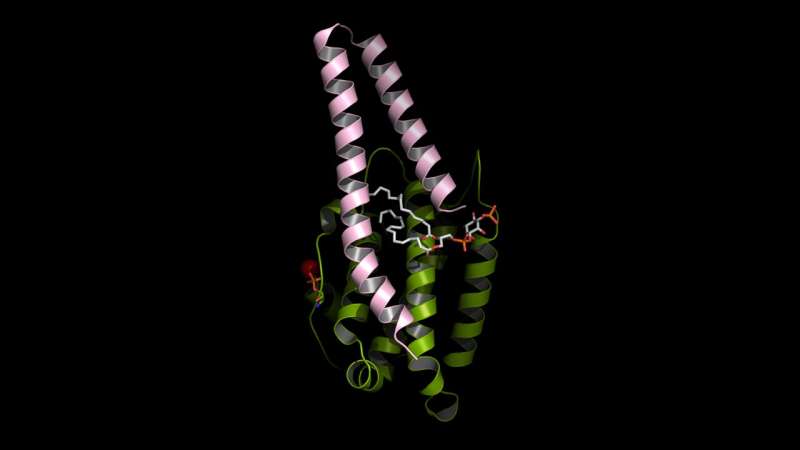This article has been reviewed according to Science X's editorial process and policies. Editors have highlighted the following attributes while ensuring the content's credibility:
fact-checked
peer-reviewed publication
trusted source
proofread
Study shows overlooked lipid is connected to ancient cellular pathway with links to cancer

Within the family of cell membrane lipids known as phosphoinositides and the kinase enzymes that regulate them, phosphoinositide 3-kinases (PI3Ks) have been cast in a starring role as scientists study their involvement in cancer, diabetes and many cellular activities.
The presence of PI3Ks in the scientific limelight has overshadowed other members of this lipid enzyme family, including phosphatidylinositol-5-phosphate 4-kinases (PI5P4Ks). Brooke Emerling, Ph.D., co-director of and associate professor in the Cancer Metabolism and Microenvironment Program at Sanford Burnham Prebys, is contributing to a revival of interest in this underappreciated set of enzymes.
Emerling and team have now shown for the first time that PI5P4K activity is connected to the regulation of an ancient signaling system called the hippo pathway, which is found in a wide variety of organisms and is known to help human organs grow and control their size. In a study published in Science Signaling, Emerling and co-senior author Raymond Blind, Ph.D., at Vanderbilt University Medical Center, have shared their findings, which open new research avenues to tackle aggressive cancers.
"Up till now, my lab has focused on what these enzymes are, why PI5P4Ks are important and how they affect tumor growth," says Emerling. "Because of the potential to target these enzymes with new drugs to treat cancer, it is important to know more about what they do and how they are regulated."
Since only a few PI5P4K regulators were known, the research team screened 29 other potential regulators and found two—core components of the hippo pathway called MST1 and MST2—that were the most effective at blocking PI5P4K activity.
"These results are exciting because the hippo pathway is a major pathway that's dysregulated in cancer," notes Emerling. "The field has found it very difficult to develop drugs that directly target the hippo pathway, so this result piqued our interest, as we may be able to target PI5P4Ks to get to cancers with abnormal hippo signaling."
Additional studies with genetically engineered cells revealed that PI5P4K activity was elevated in the absence of MST1 and MST2, suggesting that these two enzyme kinases might "control" PI5P4K.
"Our hypothesis is that MST1 and MST2 keep PI5P4Ks in check," says Emerling. "So when you lose MST activity in cancer cells, they can keep turning on PI5P4K, and then you get more aggressive metastatic tumors."
The researchers also looked at how PI5P4K activity influenced other components of the hippo pathway and found that reduced PI5P4K activity was linked to decreased activity in the Yes-associated protein (YAP), which sits at the end of the hippo pathway—and is directly linked to cancer.
"YAP is often used in the clinic as a biomarker for aggressive tumors, and it's really easy to stain for YAP in patient biopsies," says Emerling. "Researchers have been trying to make drugs that target YAP, and now we see a lot of potential in trying to instead inhibit PI5P4K as a possible treatment for cancers that have YAP activation. Several compounds have already been developed to inhibit PI5P4K and could be used in future studies to explore this approach."
To follow up on this newly published research, the team plans to use structural biology to better understand exactly how the lipids and proteins interact at the intersection of the PI5P4K and hippo pathways. The scientists also plan to conduct preclinical studies to see if they can inhibit PI5P4K in mouse tumor models, measure the effects on YAP activity and determine if this might eventually benefit cancer patients in the future.
The study builds on Emerling's previous work published in Science Advances that described how prostate cancer cells can be killed by targeting one of the PI5P4Ks called PI5P4Kα.
"This work has a great potential to help people, and we're dedicated to advancing this research so we can make that happen," adds Emerling.
Additional authors on the study include Lavinia Palamiuc, Ryan M. Loughran, Gurpreet K. Arora, Vivian Tieu, Kyanh Ly, Alicia Llorente, Sophia Crabtree, Archna Ravi and Rabi Murad—all at Sanford Burnham Prebys; Jared L. Johnson and Jenny C. Y. Wong from Weill Cornell Medicine; Zeinab Haratipour and Woong Jae Choi from Vanderbilt University Medical Center; and Thorsten Wiederhold from Cell Signaling Technology, Inc.
More information: Lavinia Palamuc et al, Hippo and PI5P4K signaling intersect to control the transcriptional activation of YAP, Science Signaling (2024). DOI: 10.1126/scisignal.ado6266

















